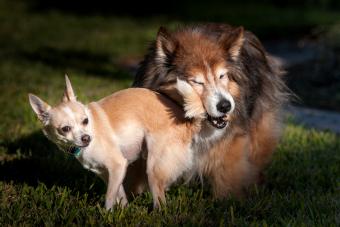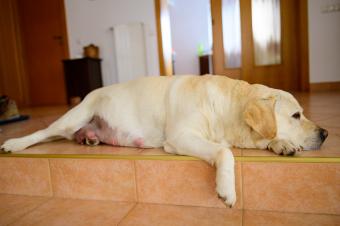
If you own an unspayed female, knowing the signs a dog is coming into season can be very important in managing their reproductive cycle. Learning the stages of the cycle will allow you to recognize symptoms such as personality changes, appetite changes, and more as indications a female dog is entering heat, rather than something that requires a visit to the veterinarian. It could also help you prevent having new puppies on your hands when you didn't plan for them and allow you to plan for puppies when you do want them.
Recognizing the Symptoms of a Dog in Heat
To better understand the many signs a dog is coming into season, it's best to break down the various stages of the average 21-day heat cycle. Doing so can help you determine which part of the cycle your female dog is in, and it can also help in planning or preventing a litter. Keep in mind that the 21-day cycle is just a guideline, and every dog is different.
According to Veterinary Centers of America, a heat cycle can last anywhere from seven days to two weeks long or more. The heat cycle usually occurs twice a year, though some dogs will go more or less than six months between cycles. Because heat cycles only happen for a short time about twice a year, they are referred to as "seasons," which is the basis for the phrase that a dog is "coming into season."
Week One: Proestrus
Proestrus is the term used to describe the initial portion of the heat cycle. This period can last from seven to 10 days, but many female dogs typically experience about nine days of proestrus. According to DogBreedInfo.com, the first sign that the dog is going into heat is the swelling of the vulva. However, the swelling as it relates to the bleeding isn't completely predictable. The vulva could swell one week to a day before the bleeding starts.
During this time, you'll notice many -- but perhaps not all -- of the following symptoms of a dog in heat.
- A personality change: Changes can range from quite mild to more severe. Sometimes a female dog will become more affectionate and clingy with their owner, and other times, they may seem a bit standoffish or grumpy. Some female dogs act directly in opposition to their usual character, while others simply augment their natural personality.

- Appetite changes: For a female dog in heat, not eating much during this first week of the estrus cycle isn't unusual. On the other hand, some female dogs become hungrier to the point of raiding the trash bin for discarded leftovers. Whatever the change is, taking note of it can be a significant clue that the heat cycle has begun.

- Swelling of the vulva: The amount of vulva swelling varies from one female to the next. Some dogs swell ever so slightly, while others swell quite a lot. As the swelling progresses, it is not only noticeable from the vulva itself, but can also be seen trailing up to the pelvic opening just below the anus.
- Bloody discharge from the vulva: The amount of bleeding also varies, but typically bleeding is light during the first few days and grows a bit heavier mid-week.
- Tail tucking: This is a tendency to guard the vulva, either by tucking the tail between the legs or sitting down whenever another dog approaches the immediate area.

Week Two: Estrus
The onset of estrus marks the fertile portion of the heat cycle, where the ovaries begin to release eggs for fertilization. During this period, symptoms include:
- Lightened discharge: Previously bright red, the discharge now lightens to a pinkish-tan stain.
- Softening of the vulva: Initial swelling subsides just enough to make the vulva soften enough for penetration.
- Tail flagging and flirting: Whereas a female dog may previously have tucked her tail to fend off a male's advances, she now begins to behave flirtatiously. This can include inviting the male to mount by turning her rear toward him and holding the tail high and out of the way. She will fan it lightly to make sure he catches her scent. If conditions are truly right, a full mating may take place.

Week Three: Diestrus
As diestrus takes over, the fertile portion of the heat cycle comes to an end. Signs of the end of the cycle include:
Gradual disappearance of vulva swelling: Most of the swelling is gone within one week's time, but the vulva may remain slightly enlarged after the first heat cycle has taken place.
Cessation of flirting: Whether bred or not, the dam now lacks the conditions to mate and is no longer interested in flirting.

Gradual cessation of discharge: The pinkish-tan discharge of estrus once again turns red, but now tapers off over the course of the final week. When the swelling of the vulva ceases and it appears normal and free of any discharge or blood, the heat cycle is completed.
Diestrus can be extended to encompass the 63-day period of the average canine pregnancy if a breeding was successful.
The Resting Stage: Anestrus
If no pregnancy results from a breeding during the heat cycle, the female goes back into anestrus. This is the five- to 11-month period of inactivity that eventually cycles back into proestrus to begin the cycle anew.
A Dog's First Season
It's important to realize that a dog can go into her first heat as young as six months of age. The age of first heat will vary by size of dog and breed and can start anywhere from six to 15 months. If your female is still a puppy and unspayed, you need to be extra vigilant during this time and don't let her young age make you think she's safe from entering her first heat cycle.
Caring for a Dog in Heat
Your dog may be very uncomfortable during their heat cycle, and it's important to do your best to keep them comfortable. If they appear more irritable than normal, give them space and make sure children or other pets are not bothering them. On the other hand, they may want more attention and cuddling, and you should do what you can to keep them happy. Exercise is a great way to help a dog during heat, assuming they are feeling up to it and you can keep them supervised. There are three main concerns with a dog in heat for owners:
- Your dog is now highly attractive to male dogs, so it is your responsibility to keep your female dog away from other dogs until the cycle is finished. This means keeping them on-leash and supervised at all times.
- You will need to find a way to deal with her bleeding. You can keep your female dog out of areas of your house with floors that are carpeted, which are harder to clean. Get a set of baby-gates to restrict access to these rooms. Another option is to put dog diapers on your female to keep your house clean while allowing them to be anywhere in the house they like. If by chance your female does mess up a floor or other area and you need to keep them out to clean, make sure you use a crate or keep them in another room while you do this. Putting a female dog outside while you work and your dog is unsupervised in the yard can lead to an unexpected mating if a male dog is motivated enough to get over your fence.
- Dogs in heat are more likely to exhibit anxious behavior. Providing your dog with a sense of security can be incredibly beneficial to their mental health. If your dog has a special blanket, or a special toy, give that to them for an added sense of security.
Can a Spayed Dog Go Into Heat?
It is not unusual for dogs who have been spayed to show signs of going into heat a short time after they have had the ovariohysterectomy. This is called Ovarian Remnant Syndrome and is caused by some remaining ovarian tissues still functioning. These tissues secrete hormones that stimulate the signs of the heat cycle in a dog, such as the vulva swelling, discharge from the vagina, and signaling to male dogs that she is in heat. If you notice these signs, discuss with your veterinarian and they can perform a physical exam and blood tests. It may be a second surgery is needed to complete the spay surgery.
Pay Attention to the Signs
Paying attention to the symptoms when your dog goes in heat will allow you to prepare for puppies or prevent mating from taking place. Understanding and timing the cycle is imperative if you have a dog that hasn't been spayed.







